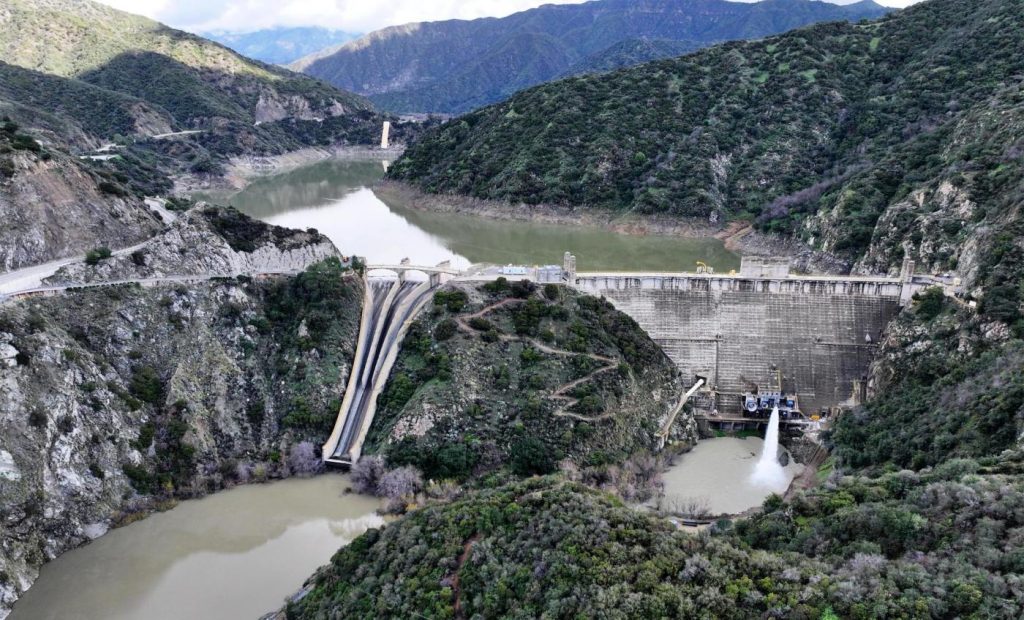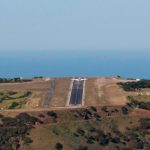For Pasadena native John T. Morris, the practical majesty and history of the Morris Dam runs close to home, as his grandfather was its lead engineer.
“He was the founding general manager of the Pasadena Water Department and chief engineer,” Morris said of his grandfather, Samuel Brooks Morris. “He started in the mid-1920s, planning for the Pine Canyon Dam because he knew we would have to have a place to store water.”
Dedicated in May of 1934 by former President Herbert Hoover, a personal friend, it became known as the Morris Dam, situated in the San Gabriel Mountains above Azusa.
Marking its 90th anniversary, and celebrating its unique role and progressive design, the American Society of Civil Engineers (ASCE) will officially recognize it as a National Historical Civil Engineering Landmark, Wednesday, Oct. 16.
The 90-year-old Morris Dam. (Photo by Jarret Liotta)
The invitation-only ceremony to take place at the dam will include John Morris, Marsia Geldert-Murphey, recent ASCE past president, and Mark Pestrella, director of the L.A. County Public Works.
“Morris Dam has been instrumental in assuring that our communities have access to safe, clean and reliable water resources,” Pestrella said. “We are proud to honor this landmark and recognize its significant place in L.A. County’s water history.”
The recognition ceremony comes just a day before national observance of “Imagine a Day Without Water” — a 10-year-old water awareness initiative spearheaded by the nonprofit U.S. Water Alliance.
“Water is our most valuable resource,” Geldert-Murphey noted, “and water infrastructure like the Morris Dam is vital to every community.”
She said the onset of unprecedented changes in weather patterns are making it more important than ever for authorities to be able to control storage of water during times of heavy rain, and also release it during droughts, offering a reliable water supply.
At full capacity, the reservoir on the north side of the dam can hold 9 billion gallons, enough to serve 230,000 L.A. County residents for a full year.
“The innovative techniques and new methods used to build the Morris Dam helped advance dam construction practices, which has benefitted the health, safety and welfare of people all over the world,” Geldert-Murphey said.
The Morris Dam, between storms on Wednesday, Feb. 7, 2024. (Photo by Dean Musgrove, Los Angeles Daily News/SCNG)
Related Articles
A La Niña winter is coming. Here’s what that could mean for California and the US
Santa Clara Valley Water District election: No drought right now, but drama and big decisions take center stage
Proposition 4: California’s $10 billion ballot measure for wildfires, water projects and heat waves explained
Oil and shipping companies to pay $3.3 million for polluting the Bay in settlement with environmentalists
Judge orders EPA to study risk from fluoride in drinking water
Just before midnight on March 12, 1928, the St. Francis Dam, 10 miles north of Santa Clarita, suddenly gave way, releasing a 140-foot-high wave of water that killed more than 430 people. The design flaws that, in part, led to the failure of that dam finished the career of William Mulholland, who had designed and completed it just two years earlier.
John Morris described how his grandfather was at the site the next day, learning from the mistakes and issues, which included a defective soil foundation.
“He learned his lessons and wanted to make sure he didn’t make the same mistakes on his dam,” he said.
“It set the standard,” he said of the Morris Dam, which was the first dam ever subject to new state inspection legislation that followed the St. Francis disaster, with close scrutiny by a panel of experts.
“The Morris Dam was the first major dam project approved by the California State Engineer under stringent safety review procedures adopted following the St. Francis Dam failure,” Geldert-Murphey said.
She explained that the dam was designed with foundation features that compensated for known weaknesses in the land, setting precedent for future dam projects.
“The Morris Dam also reshaped the profession by being the first gravity mass concrete dam engineered for pseudo-static seismic loads and to have its dynamic properties tested,” she said. “It was also the first to use low-heat cement to reduce internal stress.”
“As civil engineers we take pride in designing and constructing structures and sites that become legacies of our communities,” Geldert-Murphey said. “The Morris Dam is a prime example of engineering innovation.”
Morris Dam, between storms on Wednesday, Feb. 7, 2024. Part of the “Big 3 Dams” of the San Gabriel Mountains, where water is saved behind the dam from recent storms but also being released from one of two large pipes to allow more space for future rainstorms and to put water into the San Gabriel River and spreading grounds for underground water storage. (Photo by Dean Musgrove, Los Angeles Daily News/SCNG)
John Morris, who has served for 34 years on the board of the Metropolitan Water District of Southern California, remembered seeing the dam for the first time as a child. He was later brought inside by his father, Brooks T. Morris, an engineer who continued the family’s legacy in California water.
“I cannot consciously ever remember thinking about doing anything but being a civil engineer working in water,” he said. “That was my love and admiration.”
Morris’s great grandfather, B. Samuel Morris, came to California in 1882, ultimately serving as the founding director of the North Pasadena Land and Water Company in 1885.
Today his two sons, Matthew and Jeffrey, maintain the family’s legacy.
“They are fifth generation to work in California water … and forgive this expression, damn proud of it,” Morris said.
Jarret Liotta is a Los Angeles-area-based freelance writer and photographer.


